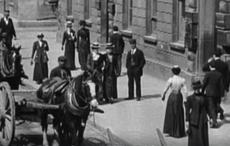When Bronx Irishman Peter Quinn published his novel 'The Banished Children of Eve' less than 15 years ago, the New York City Draft Riots were largely relegated to a dusty corner of the attic of Manhattan history.
A few historians had explored the four deadly days in the summer of 1863. But they were not widely known, and certainly not the stuff of Hollywood films or books for high school kids.
Well, all that has changed. Since Quinn’s epic novel, fellow Irish American author Kevin Baker has added another fine doorstopper of a novel called 'Paradise Alley.'
Martin Scorsese brought the Famine, the race riots and the rest of the bloody mess to the big screen with 'Gangs of New York'.
Meanwhile, right now, you can stroll over to the New York Historical Society and see 'Lincoln and New York', which explores “the most beloved leader New York ever hated.”
The Irish, of course, were generally disdainful of Lincoln. They had been embraced by Tammany Hall and the Democratic Party, and spit on by Lincoln’s more upper class Republican Party.
Lincoln also supported the U.S. Civil War, which many Irish were forced to fight once the draft was announced in 1863, spurring the riots. This is summed up by the bitter line in the song “Paddy’s Lament”:
“When we got to Yankee Land, / They shoved a gun into our hand, / Sayin’ paddy you must go and fight for Lincoln.”
Finally, one of America’s top selling authors has not only written his own book about this bleak moment in New York Irish history. He is also offering a rare glimpse into the actual history of the Draft Riots as they unfolded in 1863.
If you have not heard of Walter Dean Myers, then you have not been near a high school classroom for awhile. Myers books are widely taught, particularly in big city schools.
Myers new book, 'Riot,' explores those horrible days in July of 1863. At the center of the book is a 15-year-old girl named Claire, whose father was black and whose mother was an Irish immigrant.
Given the virulent racism of the time, this may seem far-fetched. But the fact is free blacks and Irish immigrants were often shoved into the same poor New York neighborhoods. And when they were not at each other’s throats, historians have shown that there were a significant number of such interracial couples who were actually going after other body parts.
Needless to say, however, when the Drat Riots broke out in July of 1863, a large number of Irish immigrants targeted New York’s small African American community.
Lincoln had just announced the draft. Immigrants who had just arrived in the U.S. were now going to be forced to fight in the U.S. Civil War.
Things were only made worse when it emerged that you could buy your way out of the draft for $300, “more than a year’s income for the recent immigrant Irish,” as Myers himself put it recently.
What followed was one of the city’s darkest moments. For four days, blood ran in the streets on Manhattan. Stores were looted.
Blacks were targeted, but so were the wealthy elite. The Irish and other rioters were angry at those above and below them.
After studying the draft riots, Baker once told me that their effect on the city was probably more jarring than that of 9/11 to present day New Yorkers.
Believe it or not, there is now a way to judge that comparison. In conjunction with the release of his book, Myers is also running a contest for teachers who use the draft riots in their classrooms.
The prize? A collection of actual articles from The New York Tribune, The New York Herald, The New York Times, The Philadelphia Press, The Newark (NJ) Daily Advertiser and other newspapers which covered the draft riots.
“These documents represent not only an historical perspective on the New York Draft Riots, which happened in a dark time in the city,” Myers said recently.
“But also they reflect a rapidly disappearing time when all news and record of an incident was reported by just a few sources.”
The winners will be announced at the New York Historical Society on November 11.
Inevitably, a question arises: Is this all Draft Riots overkill? Too much of an important thing?
Maybe. But then again, we are still struggling with race and poverty in New York, so maybe these lessons bear repeating.




Comments